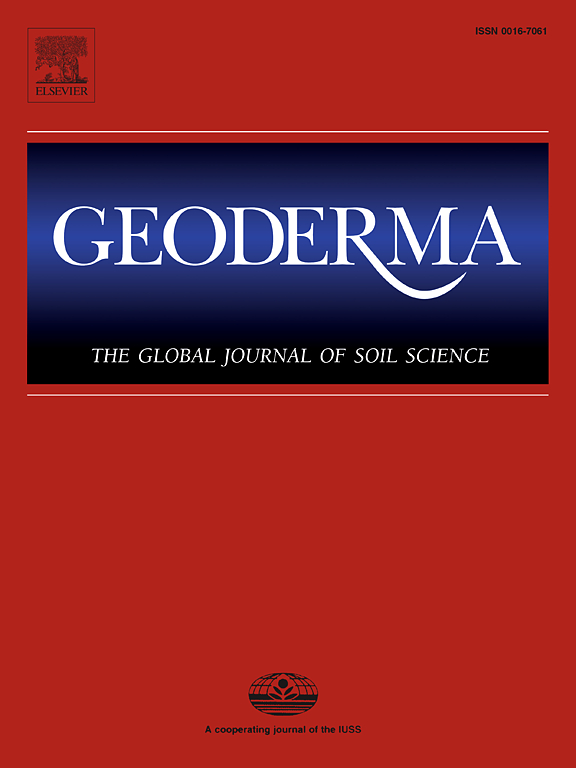The influence of fine fraction content on storage and retention of soil organic carbon in Vertisols of subtropical Australia
IF 5.6
1区 农林科学
Q1 SOIL SCIENCE
引用次数: 0
Abstract
The proportion of fine mineral particles in soils is a broadly used predictor of soil organic carbon (SOC) storage based on the potential enhancement of organo-mineral associations with increasing mineral surface area. However, the influence of increasing fine fraction content on SOC pools remain understudied in high clay soils (>50 % clay). We investigated SOC storage across paired native and cropped Vertisols from subtropical Australia, spanning a range of fine fraction (soil minerals < 53 µm) contents from 481-927 g fine fraction kg−1. The free particulate organic matter (fPOM), occluded POM (oPOM) and fine mineral-associated organic matter (fine-MAOM) were isolated by density and particle-size fractionation to assess SOC storage along the fine fraction gradient. The role of other mineral properties, such as specific surface area, was also examined. Overall, native soils revealed SOC in the unfractionated soil and the SOC fractions were poorly related to fine fraction content. Moreover, specific surface area increased substantially with fine fraction content, but SOC coverage on mineral surfaces was low (15–23 %), suggesting that MAOM formation is unrelated to the mineral surface area. By comparing native and cropped soils, we found that greater fine fraction contents did not enhance SOC retention in any fraction in the paired-cropped soils, indicating SOC retention is decoupled from fine fraction content in these Vertisols. We conclude that although fine-MAOM is important for SOC storage (storing 46–85 % of SOC in these soils), improved soil practices should prioritise the management of POM to maintain SOC in the fine-MAOM fraction of fine-textured Vertisols.
澳大利亚亚热带倒灌土壤中细粒含量对土壤有机碳储存和滞留的影响
土壤中细小矿物颗粒的比例是一个广泛使用的土壤有机碳(SOC)储量预测指标,其基础是有机-矿物关联随着矿物表面积的增加而增强。然而,在高粘土(50%粘土)中,增加细粒含量对有机碳库的影响尚未得到充分研究。我们研究了澳大利亚亚热带原生和种植的有机碳储量,涵盖了一系列精细组分(土壤矿物质<;481-927 g细馏分kg−1,含量53µm。采用密度分馏和粒度分馏方法分离游离颗粒有机质(fPOM)、封闭颗粒有机质(oPOM)和细矿物伴生有机质(fine- maom),沿细颗粒梯度评估有机碳储量。其他矿物性质的作用,如比表面积,也进行了检查。总体而言,原生土壤在未分块土壤中显示出有机碳,且有机碳组分与细碎组分含量的相关性较差。此外,随着细粒组分含量的增加,比表面积大幅增加,但矿物表面有机碳覆盖率较低(15 ~ 23%),表明MAOM的形成与矿物表面积无关。通过对原生土壤和茬耕土壤的比较,我们发现茬耕土壤中较高的细粒含量并没有增加任何组分的有机碳保持,这表明土壤中有机碳保持与细粒含量是不耦合的。我们得出结论,尽管细粒maom对有机碳的储存很重要(在这些土壤中储存了46 - 85%的有机碳),但改善土壤实践应优先管理POM,以保持细粒maom部分的有机碳。
本文章由计算机程序翻译,如有差异,请以英文原文为准。
求助全文
约1分钟内获得全文
求助全文
来源期刊

Geoderma
农林科学-土壤科学
CiteScore
11.80
自引率
6.60%
发文量
597
审稿时长
58 days
期刊介绍:
Geoderma - the global journal of soil science - welcomes authors, readers and soil research from all parts of the world, encourages worldwide soil studies, and embraces all aspects of soil science and its associated pedagogy. The journal particularly welcomes interdisciplinary work focusing on dynamic soil processes and functions across space and time.
 求助内容:
求助内容: 应助结果提醒方式:
应助结果提醒方式:


